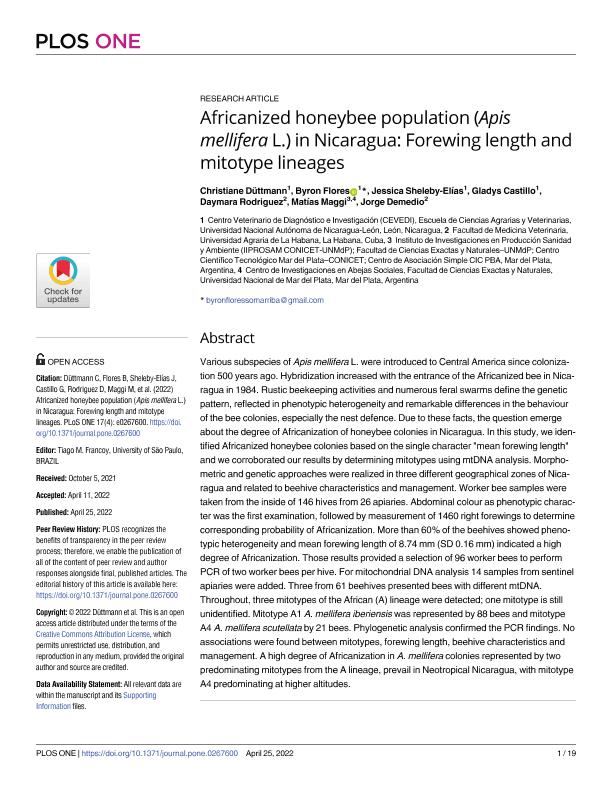Artículo
Africanized honeybee population (Apis mellifera L.) in Nicaragua: Forewing length and mitotype lineages
Düttmann, Christiane; Flores, Byron; Sheleby Elías, Jessica; Castillo, Gladys; Rodriguez, Daymara; Maggi, Matías Daniel ; Demedio, Jorge
; Demedio, Jorge
 ; Demedio, Jorge
; Demedio, Jorge
Fecha de publicación:
04/2022
Editorial:
Public Library of Science
Revista:
Plos One
ISSN:
1932-6203
Idioma:
Inglés
Tipo de recurso:
Artículo publicado
Clasificación temática:
Resumen
Various subspecies of Apis mellifera L. were introduced to Central America since colonization 500 years ago. Hybridization increased with the entrance of the Africanized bee in Nicaragua in 1984. Rustic beekeeping activities and numerous feral swarms define the genetic pattern, reflected in phenotypic heterogeneity and remarkable differences in the behaviour of the bee colonies, especially the nest defence. Due to these facts, the question emerge about the degree of Africanization of honeybee colonies in Nicaragua. In this study, we identified Africanized honeybee colonies based on the single character "mean forewing length"and we corroborated our results by determining mitotypes using mtDNA analysis. Morphometric and genetic approaches were realized in three different geographical zones of Nicaragua and related to beehive characteristics and management. Worker bee samples were taken from the inside of 146 hives from 26 apiaries. Abdominal colour as phenotypic character was the first examination, followed by measurement of 1460 right forewings to determine corresponding probability of Africanization. More than 60% of the beehives showed phenotypic heterogeneity and mean forewing length of 8.74 mm (SD 0.16 mm) indicated a high degree of Africanization. Those results provided a selection of 96 worker bees to perform PCR of two worker bees per hive. For mitochondrial DNA analysis 14 samples from sentinel apiaries were added. Three from 61 beehives presented bees with different mtDNA. Throughout, three mitotypes of the African (A) lineage were detected; one mitotype is still unidentified. Mitotype A1 A. mellifera iberiensis was represented by 88 bees and mitotype A4 A. mellifera scutellata by 21 bees. Phylogenetic analysis confirmed the PCR findings. No associations were found between mitotypes, forewing length, beehive characteristics and management. A high degree of Africanization in A. mellifera colonies represented by two predominating mitotypes from the A lineage, prevail in Neotropical Nicaragua, with mitotype A4 predominating at higher altitudes.
Palabras clave:
AFRICANIZED BEES
,
APIS MELLIFERA
,
NICARAGUA
Archivos asociados
Licencia
Identificadores
Colecciones
Articulos (IIPROSAM)
Articulos de INSTITUTO DE INVESTIGACIONES EN PRODUCCION, SANIDAD Y AMBIENTE
Articulos de INSTITUTO DE INVESTIGACIONES EN PRODUCCION, SANIDAD Y AMBIENTE
Citación
Düttmann, Christiane; Flores, Byron; Sheleby Elías, Jessica; Castillo, Gladys; Rodriguez, Daymara; et al.; Africanized honeybee population (Apis mellifera L.) in Nicaragua: Forewing length and mitotype lineages; Public Library of Science; Plos One; 17; 4-2022; 1-19
Compartir
Altmétricas



